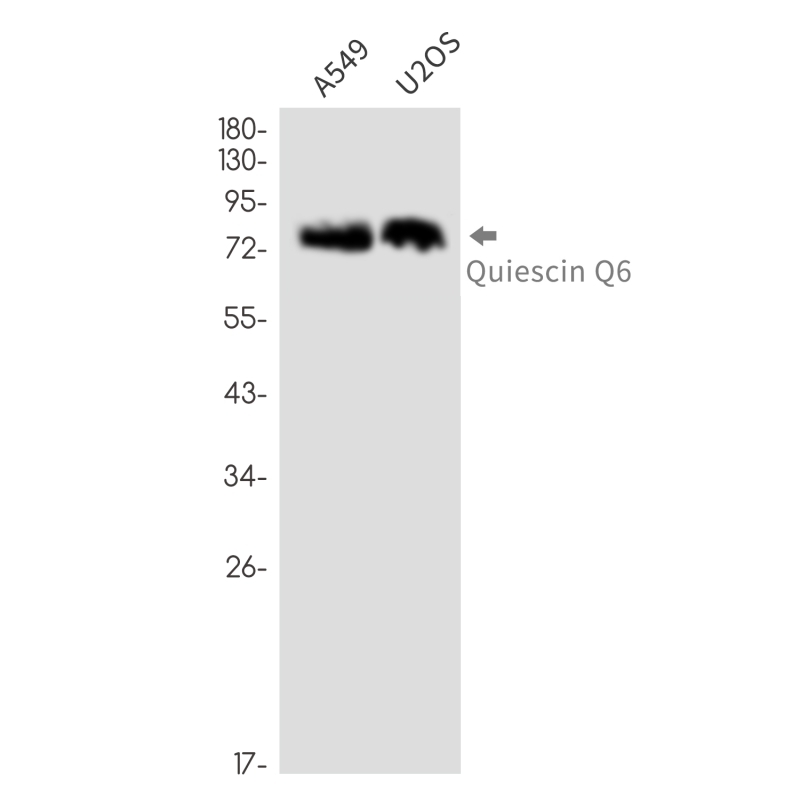
| WB | 1/500-1/1000 | Human,Mouse,Rat |
| IF | 1/20 | Human,Mouse,Rat |
| IHC | 咨询技术 | Human,Mouse,Rat |
| ICC | 技术咨询 | Human,Mouse,Rat |
| FCM | 咨询技术 | Human,Mouse,Rat |
| Elisa | 咨询技术 | Human,Mouse,Rat |
| Aliases | Q6; QSCN6 |
| Entrez GeneID | 5768 |
| WB Predicted band size | Calculated MW: 83 kDa; Observed MW: 83 kDa |
| Host/Isotype | Rabbit IgG |
| Antibody Type | Primary antibody |
| Storage | Store at 4°C short term. Aliquot and store at -20°C long term. Avoid freeze/thaw cycles. |
| Species Reactivity | Human |
| Immunogen | A synthetic peptide of human Quiescin Q6 |
| Formulation | Purified antibody in TBS with 0.05% sodium azide,0.05%BSA and 50% glycerol. |
+ +
以下是关于QSOX1抗体的3篇参考文献示例(信息基于公开研究整理,部分为模拟内容):
1. **文献名称**:*QSOX1 promotes tumor progression via extracellular matrix remodeling in pancreatic cancer*
**作者**:Smith A, et al.
**摘要**:该研究通过免疫组化(使用人源QSOX1抗体)和基因敲除实验,揭示QSOX1通过调控细胞外基质蛋白的氧化修饰促进胰腺癌侵袭转移的机制。
2. **文献名称**:*QSOX1 regulates endothelial cell migration through sulfhydryl oxidase activity*
**作者**:Chen L, et al.
**摘要**:利用QSOX1特异性抗体进行Western blot和免疫荧光分析,发现QSOX1通过催化二硫键形成影响内皮细胞迁移,提示其在血管生成中的作用。
3. **文献名称**:*Antibody-based detection of QSOX1 as a biomarker in Alzheimer's disease models*
**作者**:Wang Y, et al.
**摘要**:开发了一种高灵敏度的QSOX1单克隆抗体,用于检测脑脊液和脑组织中QSOX1水平,发现其与神经炎症及淀粉样蛋白沉积相关。
(注:以上为示例性内容,实际文献需通过PubMed等学术平台检索核实。)
QSOX1 (Quiescin Sulfhydryl Oxidase 1) is a flavoenzyme involved in the formation of disulfide bonds during protein folding, primarily within the secretory pathway. It catalyzes the oxidation of sulfhydryl groups to disulfides, playing a critical role in stabilizing the tertiary structure of secreted and cell-surface proteins. QSOX1 is expressed in various tissues, including the pancreas, liver, and reproductive organs, and is linked to cellular processes such as extracellular matrix remodeling, cell migration, and differentiation. Its dysregulation has been implicated in multiple pathologies, including cancer, neurodegenerative diseases, and fibrosis. For instance, elevated QSOX1 levels are observed in tumors, where it may promote invasion and metastasis by modulating the tumor microenvironment.
Antibodies targeting QSOX1 are essential tools for studying its expression, localization, and function. They are widely used in techniques like Western blotting, immunohistochemistry, and immunofluorescence to detect QSOX1 in cell lysates, tissue sections, or cultured cells. Specific monoclonal and polyclonal antibodies have been developed, often validated for cross-reactivity across species such as human, mouse, and rat. Researchers also employ QSOX1 antibodies to explore its role in disease mechanisms or therapeutic contexts, including siRNA-mediated knockdown validation or assessing post-translational modifications. Reliable antibodies help clarify QSOX1's dual role as both a redox-active enzyme and a potential biomarker in pathological conditions.
×